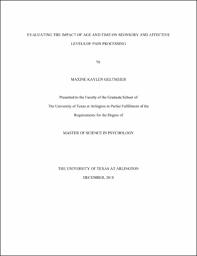
ATTENTION: The works hosted here are being migrated to a new repository that will consolidate resources, improve discoverability, and better show UTA's research impact on the global community. We will update authors as the migration progresses. Please see MavMatrix for more information.
Show simple item record
| dc.contributor.advisor | Fuchs, Perry N. | |
| dc.contributor.advisor | Peng, Yuan Bo | |
| dc.creator | Geltmeier, Maxine Kaylen | |
| dc.date.accessioned | 2019-02-26T20:08:30Z | |
| dc.date.available | 2019-02-26T20:08:30Z | |
| dc.date.created | 2018-12 | |
| dc.date.issued | 2018-11-30 | |
| dc.date.submitted | December 2018 | |
| dc.identifier.uri | http://hdl.handle.net/10106/27751 | |
| dc.description.abstract | The relationship between pain and age has been studied for decades. However, research has produced conflicting results for pain thresholds and pain affect in clinical assessments. Likewise, pre-clinical research is conflicting and sparse, limiting the extent of any overarching
conclusions. Despite conflicting results on directionality (higher thresholds verses lower thresholds), pain sensitivity and pain affect seem to change with age. Two major arguments have surfaced to explain these differences. The first is, the aging process can lead to changes in peripheral pain signals of pain pathways. The second is, higher order processes that evaluate pain information change with age.
For the current project, it was hypothesized that older animals would have diminished peripheral pain pathways due to the natural aging process; leading to decreased nociceptive behaviors for acute pain in older animals compared to younger animals. However, chronic pain
was predicted to strengthen the signals in these pathways for all age groups due to continued use of the pathway. Since older individuals have been shown to inhibit pain less effectively than younger individuals, it was also predicted that (contrary to acute pain) chronic pain should elicit greater nociceptive behaviors in older animals than in younger animals.
In this study, Sprague Dawley Rats were categorized in two groups: young and old. A limited arthritic model was used to induce pain, while the control group received saline injections. Subjects were evaluated on mechanical and thermal thresholds to evaluate sensory processing of pain. Pain affect was evaluated using the Place Escape/Avoidance Paradigm
(PEAP testing) and immunohistological assessments of c-fos expression in the anterior cingulate cortex. The current study verified that old rats have differing levels of pain sensitization and pain affect than young rats. It was determined that chronicity of pain could interact with age to alter pain processing, but did not have any main effect on threshold results or assessments of pain affect. | |
| dc.format.mimetype | application/pdf | |
| dc.language.iso | en_US | |
| dc.subject | Age | |
| dc.subject | Nociception | |
| dc.subject | Affect | |
| dc.subject | Chronic pain | |
| dc.title | Evaluating the Impact of Age and Time on Sensory and Affective Levels of Pain Processing | |
| dc.type | Thesis | |
| dc.degree.department | Psychology | |
| dc.degree.name | Master of Science in Psychology | |
| dc.date.updated | 2019-02-26T20:08:31Z | |
| thesis.degree.department | Psychology | |
| thesis.degree.grantor | The University of Texas at Arlington | |
| thesis.degree.level | Masters | |
| thesis.degree.name | Master of Science in Psychology | |
| dc.type.material | text | |
| dc.creator.orcid | 0000-0001-8171-3595 | |
Files in this item
- Name:
- GELTMEIER-THESIS-2018.pdf
- Size:
- 3.535Mb
- Format:
- PDF
This item appears in the following Collection(s)
Show simple item record


